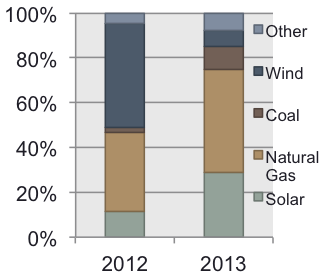History Suggests a Positive Outlook
 Despite the difficult economic conditions over the last decade, PV technology has continued to grow at a remarkable rate and is showing no signs of slowing down. 31.1 GW of PV systems were installed around the world in 2012, up from 30.4 GW in 2011. From these strong numbers, PV remains the third most important renewableenergy in terms of global installed capacity.With Europe accounting for 55% of these new capacities in 2012, PV was, for the second year in a row, the #1 new source of electricity installed in Europe. The figure to the right is the percentage of new electricity generation per energy source in the United States.[1] The rapid growth between 2012 and 2013 illustrates a shift in the United States toward solar PV as a source for electricity. The figure below shows the expanding global market for PV cumulative installed capacities over the last decade.[2] If these global trends continue, solar PV installation can be expected to increase at a rate of ~50% per year.
Despite the difficult economic conditions over the last decade, PV technology has continued to grow at a remarkable rate and is showing no signs of slowing down. 31.1 GW of PV systems were installed around the world in 2012, up from 30.4 GW in 2011. From these strong numbers, PV remains the third most important renewableenergy in terms of global installed capacity.With Europe accounting for 55% of these new capacities in 2012, PV was, for the second year in a row, the #1 new source of electricity installed in Europe. The figure to the right is the percentage of new electricity generation per energy source in the United States.[1] The rapid growth between 2012 and 2013 illustrates a shift in the United States toward solar PV as a source for electricity. The figure below shows the expanding global market for PV cumulative installed capacities over the last decade.[2] If these global trends continue, solar PV installation can be expected to increase at a rate of ~50% per year.
Policy Will Play A Big Role
Given the historical data and future forecasts, it’s no secret that the global PV market remains a policy-driven business. PV generation costs, though rapidly becoming more competitive, are still difficult to cover compared to traditional coal and gas energy consumption. But political bodies and governments are a key factor in the expansion of the global PV market, as it is apparent that PV should become a more reliable energy source in the near future. Because of this, governments are and need to continue to make the appropriate decisions to create smart and sustainable support schemes for PV, allowing the markets to expand. Though the market is expanding in both policy-driven business and typical business schemes, Figure 2 below shows that the continuation of these policies is the most important factor for PV markets to continue growth.[3]
The Emergence of Utility-Scale Plants
When evaluating the potential of the solar photovoltaic industry in is essential to take into account the recent emergence of utility-scale plants. There are two major segments that comprise the total PV market: rooftop applications, and utility-scale plants. For years, the rooftop market has easily been greater than the utility-scale market, more than doubling it in 2012. However, this is expected to change in the upcoming years, as the utility-scale market should grow much faster. This can be explained by not just historical trends, but also from the nature of investors in leading markets, and the overall reduced opposition to ground-mounted PV systems. Assuming that policy-driven scenarios continue, the global rooftop PV market is expected to double from 2012 to 2017, but the utility-scale market could possibly quadruple in that same time, as shown in Figure 3 below.[3] Though rooftop applications would still control the majority of the market in 2017, the trends suggest that the utility-scale market would greatly narrow this gap and possible overcome it in future years. 
For more information view: [1] [2] [3]
Authors & Editors: Benjamin DeForest and Joe Donatoni


Quite fascinating and informative content. Book-marked …
Many thanks for the amazing read.